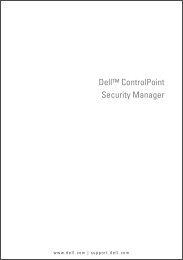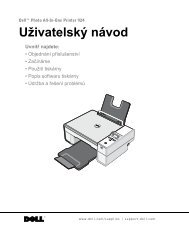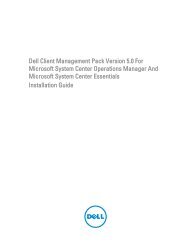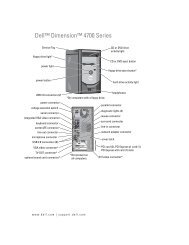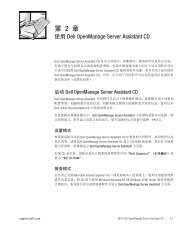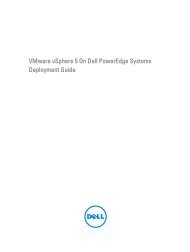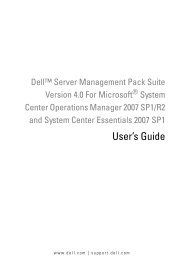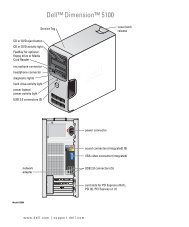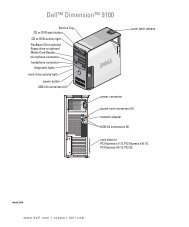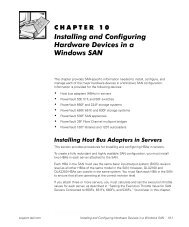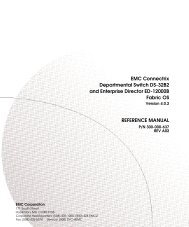- Page 1 and 2: Dell OpenManage Server Administrato
- Page 3 and 4: Contents 1 Overview . . . . . . . .
- Page 5 and 6: 4 Quick Access to Storage Status an
- Page 7 and 8: RAID Controller Read, Write, Cache,
- Page 9 and 10: Resizing the CacheCade . . . . . .
- Page 11 and 12: Connector Properties and Tasks . .
- Page 13 and 14: Number of Physical Disks per Virtua
- Page 15 and 16: 14 Protecting Your Virtual Disk wit
- Page 17 and 18: A Disk on a PERC 4/Di Controller Do
- Page 19 and 20: Supported Features on the PERC 5/ P
- Page 21 and 22: Health Status Rollup: Physical Disk
- Page 23 and 24: Overview 1 Dell OpenManage Server A
- Page 25 and 26: Version Requirements for Controller
- Page 27 and 28: • PowerVault MD1000 and MD1120 st
- Page 29 and 30: Getting Started 2 Dell OpenManage S
- Page 31 and 32: Administrator privileges are requir
- Page 33 and 34: Common Storage Tasks This section p
- Page 35 and 36: Understanding RAID Concepts 3 Stora
- Page 37: • Stripe element size—The amoun
- Page 41 and 42: Figure 3-2. Striping Disks RAID 0 C
- Page 43 and 44: Related Information: • Organizing
- Page 45 and 46: Figure 3-5. RAID 6 RAID 6 Character
- Page 47 and 48: Figure 3-6. RAID 50 RAID 50 Charact
- Page 49 and 50: Figure 3-7. RAID 60 RAID 60 Charact
- Page 51 and 52: Figure 3-8. Striping Over Mirrored
- Page 53 and 54: • Controller-supported RAID Level
- Page 55 and 56: Table 3-1. RAID Level and Concatena
- Page 57 and 58: 4 Quick Access to Storage Status an
- Page 59 and 60: Table 4-1. Component Severity Sever
- Page 61 and 62: Using Enclosure Temperature Probes
- Page 63 and 64: healthy. Once the communication pat
- Page 65 and 66: PCI Express Solid-State Device Supp
- Page 67 and 68: Table 5-1. PCIe Sub System Properti
- Page 69 and 70: Table 5-3. Physical Device Properti
- Page 71 and 72: Table 5-3. Physical Device Properti
- Page 73 and 74: Backplanes PCIe SSDs are attached t
- Page 75 and 76: Storage Information and Global Task
- Page 77 and 78: If the enclosure has virtual disks
- Page 79 and 80: Property Definition Minimum Require
- Page 81 and 82: Controllers 7 This section describe
- Page 83 and 84: • PERC H200, H700, and H800 contr
- Page 85 and 86: RAID Controller Read, Write, Cache,
- Page 87 and 88: • Write-Through—When using writ
- Page 89 and 90:
NOTE: Storage Management does not c
- Page 91 and 92:
NOTE: On replacing a SMART error dr
- Page 93 and 94:
Table 7-1. Firmware and Driver Prop
- Page 95 and 96:
Controller Components For informati
- Page 97 and 98:
Property Definition Firmware Versio
- Page 99 and 100:
Property Definition Auto replace me
- Page 101 and 102:
Property Definition Persistent Hot
- Page 103 and 104:
Available Reports • Patrol Read R
- Page 105 and 106:
Controller Components For informati
- Page 107 and 108:
Reset Configuration Does my control
- Page 109 and 110:
5 Click Execute. You can also locat
- Page 111 and 112:
Property Definition State This prop
- Page 113 and 114:
Importing Foreign Configurations So
- Page 115 and 116:
Clear Foreign Configuration Does my
- Page 117 and 118:
The following table describes prope
- Page 119 and 120:
Property Definition Bus Protocol Th
- Page 121 and 122:
Property Definition Encrypted This
- Page 123 and 124:
4 Select Set Check Consistency Rate
- Page 125 and 126:
Figure 7-1. Daisy Chain Configurati
- Page 127 and 128:
Clearing the Redundant Path View Co
- Page 129 and 130:
To locate this task in Storage Mana
- Page 131 and 132:
2 Select a controller object. 3 Sel
- Page 133 and 134:
Table 7-8. Manage Physical Disk Pow
- Page 135 and 136:
Data in the cache may also be lost
- Page 137 and 138:
If you are using Local Key Manageme
- Page 139 and 140:
Encryption Key credentials for a co
- Page 141 and 142:
To unblink the physical disk in the
- Page 143 and 144:
Convert to RAID Capable Disks On De
- Page 145 and 146:
Enclosures and Backplanes 8 Physica
- Page 147 and 148:
The Failure threshold has a default
- Page 149 and 150:
Changing the Mode on PowerVault 220
- Page 151 and 152:
Table 8-1. Component Severity Sever
- Page 153 and 154:
Property Definition Configuration T
- Page 155 and 156:
Drop-down Menu Enclosure Tasks: •
- Page 157 and 158:
View Slot Occupancy Report Does my
- Page 159 and 160:
Set Asset Data Does my enclosure su
- Page 161 and 162:
View Slot Occupancy Report Does my
- Page 163 and 164:
Property Definition Type This prope
- Page 165 and 166:
Power Supply Properties Use this wi
- Page 167 and 168:
Temperature Probe Properties and Ta
- Page 169 and 170:
Set Temperature Probe Properties an
- Page 171 and 172:
Connectors 9 A controller contains
- Page 173 and 174:
Recommended RAID Levels: - PERC 4/D
- Page 175 and 176:
Table 9-1. Component Severity Sever
- Page 177 and 178:
Connector Tasks: Rescan Connector D
- Page 179 and 180:
Selecting this option clears the re
- Page 181 and 182:
RAID Controller Batteries 10 Some R
- Page 183 and 184:
Table 10-1. Battery Properties Prop
- Page 185 and 186:
Property Definition Maximum Learn D
- Page 187 and 188:
The battery learn cycle discharges
- Page 189 and 190:
11 Physical Disks or Physical Devic
- Page 191 and 192:
• If you want to include the new
- Page 193 and 194:
Physical Disk or Physical Device Pr
- Page 195 and 196:
Property Definition Rebuilding—Da
- Page 197 and 198:
Property Definition Failure Predict
- Page 199 and 200:
Property Definition Serial No. This
- Page 201 and 202:
into a server or an enclosure. If t
- Page 203 and 204:
Rebuilding a disk may take several
- Page 205 and 206:
Use the Offline task to deactivate
- Page 207 and 208:
If Revertible Hot Spare is enabled
- Page 209 and 210:
Convert to RAID Capable Disk This t
- Page 211 and 212:
Virtual Disks 12 In order to implem
- Page 213 and 214:
virtual disks can result in pockets
- Page 215 and 216:
For related information, see Consid
- Page 217 and 218:
Calculation for Maximum Virtual Dis
- Page 219 and 220:
To reconfigure a virtual disk: 1 Re
- Page 221 and 222:
Table 12-1. Virtual Disk Reconfigur
- Page 223 and 224:
Table 12-1. Virtual Disk Reconfigur
- Page 225 and 226:
The following table describes some
- Page 227 and 228:
Virtual Disk Properties and Tasks U
- Page 229 and 230:
Property Definition Background Init
- Page 231 and 232:
1 Expand the Storage tree object to
- Page 233 and 234:
however, cancel the background init
- Page 235 and 236:
in Resynching state causes the virt
- Page 237 and 238:
• have Self Encryption Drives (SE
- Page 239 and 240:
NOTE: The CERC SATA1.5/2s controlle
- Page 241 and 242:
Create Virtual Disk Advanced Wizard
- Page 243 and 244:
The algorithm determines the candid
- Page 245 and 246:
Connector 0 The Connector section o
- Page 247 and 248:
the controller. In most cases, the
- Page 249 and 250:
This option is available only if th
- Page 251 and 252:
Monolithic, PERC H800, and PERC H81
- Page 253 and 254:
NOTE: The PERC 4/SC, 4/DC, 4e/DC, 4
- Page 255 and 256:
Considerations for Initialize The i
- Page 257 and 258:
- Slow Initialize - Fast Initialize
- Page 259 and 260:
3 Select the Virtual Disks object.
- Page 261 and 262:
Unmirror Does my controller support
- Page 263 and 264:
To locate this task in Storage Mana
- Page 265 and 266:
13 Moving Physical and Virtual Disk
- Page 267 and 268:
• Saving the New Controller Confi
- Page 269 and 270:
14 Protecting Your Virtual Disk wit
- Page 271 and 272:
Global Hot Spare Protection Policy
- Page 273 and 274:
A dedicated hot spare can only be a
- Page 275 and 276:
NOTE: When using the BIOS on a CERC
- Page 277 and 278:
15 CacheCade Using Solid State Driv
- Page 279 and 280:
BIOS Terminology 16 The terminology
- Page 281 and 282:
Troubleshooting 17 This section con
- Page 283 and 284:
Replacing a Failed Disk You may nee
- Page 285 and 286:
After retrieving any viable data fr
- Page 287 and 288:
• The virtual disk is non-redunda
- Page 289 and 290:
3 Restore the virtual disk from the
- Page 291 and 292:
Resolution: Perform a Rescan Contro
- Page 293 and 294:
Receive a “Bad Block” Alert wit
- Page 295 and 296:
A Corrupt Disk or Drive Message Sug
- Page 297 and 298:
PCIe SSD Troubleshooting Peripheral
- Page 299 and 300:
Frequently Asked Questions 18 This
- Page 301 and 302:
3 To display more information about
- Page 303 and 304:
Supported Features A Different cont
- Page 305 and 306:
Table A-1. Controller Tasks Support
- Page 307 and 308:
Virtual Disk Tasks Table A-5. Virtu
- Page 309 and 310:
Virtual Disk Specifications Table A
- Page 311 and 312:
Table A-6. Virtual Disk Specificati
- Page 313 and 314:
Read, Write, and Disk Cache Policy
- Page 315 and 316:
Controller Tasks Table A-10. Contro
- Page 317 and 318:
Table A-13. Physical Disk Tasks Sup
- Page 319 and 320:
Table A-15. Virtual Disk Specificat
- Page 321 and 322:
Read, Write, and Disk Cache Policy
- Page 323 and 324:
Table A-19. Controller Tasks Suppor
- Page 325 and 326:
Battery Tasks Table A-20. Battery T
- Page 327 and 328:
Table A-23. Virtual Disk Tasks Supp
- Page 329 and 330:
Table A-24. Virtual Disk Specificat
- Page 331 and 332:
Table A-26. Read, Write, and Cache
- Page 333 and 334:
Controller Tasks Table A-28. Contro
- Page 335 and 336:
Table A-28. Controller Tasks Suppor
- Page 337 and 338:
Connector Tasks Table A-30. Control
- Page 339 and 340:
Virtual Disk Tasks Table A-32. Virt
- Page 341 and 342:
Table A-33. Virtual Disk Specificat
- Page 343 and 344:
Table A-33. Virtual Disk Specificat
- Page 345 and 346:
Table A-35. Read, Write, and Cache
- Page 347 and 348:
Battery Tasks Table A-38. Battery T
- Page 349 and 350:
Table A-41. Virtual Disk Tasks Supp
- Page 351 and 352:
Table A-43. Virtual Disk Specificat
- Page 353 and 354:
Supported Features on the PERC S100
- Page 355 and 356:
Table A-49. Virtual Disk Specificat
- Page 357 and 358:
Table A-51. Read, Write, and Cache
- Page 359 and 360:
Battery Tasks Table A-54. Battery T
- Page 361 and 362:
Table A-57. Virtual Disk Tasks Supp
- Page 363 and 364:
Table A-60. Backplane Tasks for SCS
- Page 365 and 366:
B Determining the Health Status for
- Page 367 and 368:
Table B-3. Health Status Rollup: Ph
- Page 369 and 370:
Table B-6. Health Status Rollup: Vi
- Page 371 and 372:
Health Status Rollup: One Enclosure
- Page 373 and 374:
Table B-13. Health Status Rollup: L



